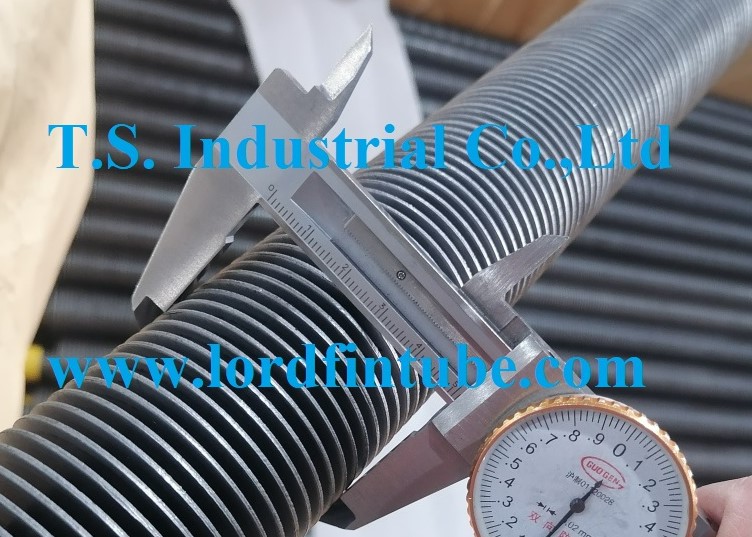Lord Fin Tube-How to Classify of finned tubes?
Finned tubes are critical components in heat exchange systems, used extensively to enhance the efficiency of heat transfer processes. The addition of fins increases the surface area available for heat exchange, thereby improving the overall heat transfer rate. Finned tubes can be classified based on various criteria, including processing technology, fin shape, material similarity, material type, and application.
1. Classification Based on Processing Technology
This classification is based on how the fins are attached or formed onto the tubes:
a) Extruded Fin Tube: Fins are extruded from the base tube material itself, ensuring a strong mechanical bond and high thermal conductivity.
b) Welding Forming Finned Tube:
- High-Frequency Welding Finned Tube: Fins are welded to the tube using high-frequency electrical resistance welding, providing a robust bond.
- Submerged Arc Welding Fin Tube: Uses submerged arc welding for attaching fins, suitable for thicker fins and tubes.
c) Rolling Forming Finned Tube: Fins are mechanically rolled onto the tubes, creating a tight fit and enhancing heat transfer efficiency.
d) A Set of Shaped Fin Tube: Custom-shaped fins designed to fit specific heat exchange requirements, often produced through specialized forming processes.
e) Casting Finned Tube: Fins and tubes are cast together as a single piece, providing excellent mechanical strength and thermal conductivity.
f) Tension Wound Finned Tube: Fins are wound around the tube under tension, ensuring a tight mechanical bond.
g) Insert Tube: Fins are inserted into grooves or slots in the tube, often used for repair or retrofit applications.
2. Classification Based on Fin Shape
The shape of the fins influences the heat transfer characteristics and application suitability:
a) Square Finned Tube: Fins have a square cross-section, offering a large surface area and good mechanical stability.
b) Circular Finned Tube: Fins are circular in shape, providing a uniform heat transfer surface and often used in applications requiring a consistent heat profile.
c) Spiral Finned Tube: Fins are arranged in a spiral around the tube, enhancing turbulence and heat transfer efficiency.
d) Longitudinal Finned Tube: Fins run longitudinally along the length of the tube, suitable for applications with directional heat flow.
e) Corrugated Fin Tube: Fins have a corrugated or wavy shape, increasing surface area and promoting turbulent flow.
f) Helical Serrated Finned Tube: Helical fins with serrations enhance heat transfer by disrupting boundary layers and promoting turbulence.
g) Needle-Shaped Fin Tube: Fins are needle-like, providing high surface area for compact heat exchangers.
h) Overall Plate Fin Tube: Fins are shaped like plates that cover the entire tube surface, offering a large heat transfer area.
i) Inner Finned Tube: Fins are located inside the tube, enhancing heat transfer for internal fluid flows.
3. Classification Based on the Similarity of Fin and Tube Materials
This classification considers whether the fins and tubes are made from the same or different materials:
a) Single Metal Finned Tube: Both the fins and the tube are made from the same metal, ensuring uniform thermal expansion and good thermal conductivity.
b) Double Metal Composite Fin Tube: Fins and tubes are made from different metals, often chosen to optimize thermal conductivity, mechanical strength, and corrosion resistance.
4. Classification of Single Metal Fin Tubes Based on Material
Single metal fin tubes can be further classified based on the specific metal used:
a) Copper Fin Tube: Offers excellent thermal conductivity and corrosion resistance, commonly used in HVAC applications.
b) Aluminum Finned Tube: Lightweight and cost-effective with good thermal conductivity, used in air-cooled heat exchangers.
c) Carbon Steel Finned Tube: Durable and economical, suitable for industrial applications with moderate temperatures.
d) Stainless Steel Finned Tube: High corrosion resistance and strength, ideal for aggressive environments and high temperatures.
e) Cast Iron (Cast Steel) Finned Tubes: Strong and durable, used in heavy-duty applications where mechanical robustness is critical.
5. Classification Based on Application
Finned tubes are designed to meet the requirements of various applications:
a) Air Conditioning with Finned Tube: Used in HVAC systems to enhance air-to-refrigerant heat transfer.
b) Air Cooling Fin Tube: Employed in air-cooled heat exchangers to dissipate heat to the surrounding air.
c) Boiler: Water Cooling Wall, Coal, Air Preheater with Fin Tube: Utilized in boilers for water cooling walls and air preheating, improving overall efficiency.
d) Industrial Waste Heat Recovery with Finned Tube: Captures and reuses waste heat from industrial processes, improving energy efficiency.
e) Other Special-Purpose Finned Tubes: Customized designs for unique applications, such as nuclear reactors, petrochemical plants, and marine environments.


